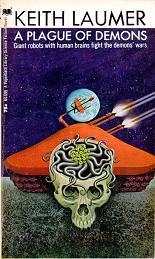
A Plague of Demons
Keith Laumer
159 pages
published in 1965
The advantage of reading a Keith Laumer novel is that they're so short you can read two of them in the time it takes to get through even half a modern novel. So after Worlds of the Imperium I decided I would indulge into another Laumer novel I hadn't read in over a decade. Reading them back to back it was interesting to see the simularities between the two novels. Both are partially set in Northern Africa, both star tough, grizzled loners whose name start with a B, and in both the hero gets involved in an operation way over his head and discovers the true reality of his world. Though really, that last bit is true of almost every straight science fiction novel Laumer ever wrote.
Not that Laumer wrote to a formula, but he knew what his strenghts were, what he liked to write about and what his readers liked to read. Certainly he always manages to hit my buttons. A Plague of Demons is no exception. It's as fast-paced as the best of his work, with a nice dash of understated humour, in a writing style that owes a lot to the great American hardboiled tradition, as well as some of Ian Fleming's work.
The plot is simple. John Bravais, secret agent working for Central Bureau of Intelligence is called to Algeria, to the war that's scheduled to run there to find the answer to a question that has been puzzling his superiors for some time now: why so many soldiers remain missing in action. Real war may no longer be on the menu, thanks to the nuclear stalemate between the various superpowers, but United Nation regulated police actions and "internal power realignments" are still common, fought according to a strict protocol enforced by the UN security police. The fear is that those disappearing soldiers are actually used by an enemy superpower to create an army of surgically enhanced supersoldiers. Bravais' mission is to see what happens when the Free Algerians and Imperial Moroccans mix it up, to see if he can spot any suspicious activity.
But when he does so, using gadgets James Bond would be envious off, he quickly realises that whatever is going on, isn't as mundane as one superpower trying to gain a march on another. When he sees one tank drifting off the designated battlefield, he notices to his horror that what is waiting for it isn't human, but something else entirely, an alien dog thing and something that looks human at first glance, but turns out to be just a very advanced disguise, hiding something that should not exist.
Once he learns the truth behind the disapperances, the mood of the novel changes. Bravais no longer is the hunter, but the hunted and despite getting an upgrade that makes him into one of the supersoldiers his superior was so worried about, he's barely able to keep one step ahead of his alien enemies. Branded a traitor by his own people, he flees from safehouse to safehouse, but in the end his luck runs out and he's killed in hand to hand combat with the creatures.
Only to awake on a strange planet in a strange body, that of a huge battletank, which his subconscious mind appears to be controlling. That's right, he's become a Bolo! A Bolo, if you're not familiar with the term, is to a tank what a tank is to a plastic model. Huge machines, with guns that could annihilate cities if not continents, they pop up in various of Laumer's works. Now Bravais is the computer controlling one, though not yet consciously and he has to find a way to not just free himself, but find out where he is, if there are others like him and see if he can liberate them as well, then lead them in a battle for freedom and back to Earth...
This is what I like about Laumer, that he puts his heroes in progressively more dangerous situations which they win through by sheer grit. Yes, it's not at all original, but Laumer does it with such panache and grace, not to mention a big dollop of humour.
Read more about:
Keith Laumer,
A Plague of Demons,
science fiction,
book review